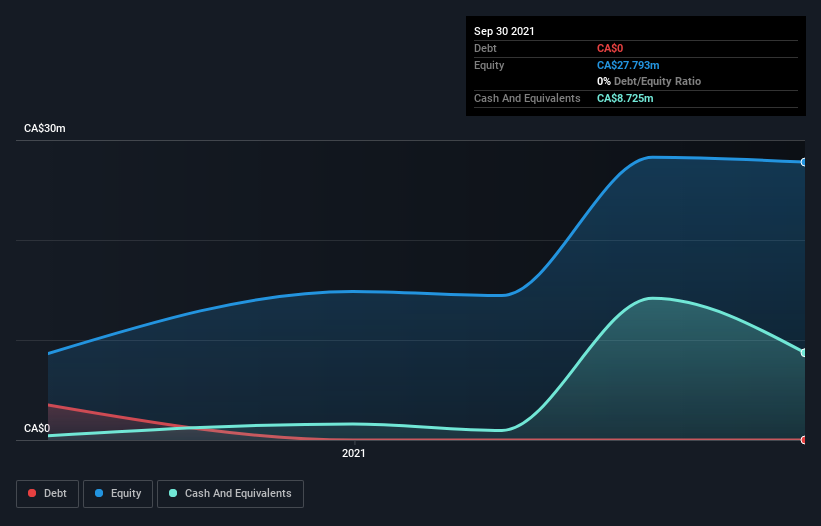- Canada
- /
- Metals and Mining
- /
- TSXV:TIN
Here's Why We're A Bit Worried About Whitehorse Gold's (CVE:WHG) Cash Burn Situation
There's no doubt that money can be made by owning shares of unprofitable businesses. For example, biotech and mining exploration companies often lose money for years before finding success with a new treatment or mineral discovery. Having said that, unprofitable companies are risky because they could potentially burn through all their cash and become distressed.
So should Whitehorse Gold (CVE:WHG) shareholders be worried about its cash burn? For the purpose of this article, we'll define cash burn as the amount of cash the company is spending each year to fund its growth (also called its negative free cash flow). The first step is to compare its cash burn with its cash reserves, to give us its 'cash runway'.
See our latest analysis for Whitehorse Gold
How Long Is Whitehorse Gold's Cash Runway?
A company's cash runway is calculated by dividing its cash hoard by its cash burn. When Whitehorse Gold last reported its balance sheet in September 2021, it had zero debt and cash worth CA$8.7m. Looking at the last year, the company burnt through CA$11m. Therefore, from September 2021 it had roughly 9 months of cash runway. That's quite a short cash runway, indicating the company must either reduce its annual cash burn or replenish its cash. You can see how its cash balance has changed over time in the image below.

How Is Whitehorse Gold's Cash Burn Changing Over Time?
Because Whitehorse Gold isn't currently generating revenue, we consider it an early-stage business. Nonetheless, we can still examine its cash burn trajectory as part of our assessment of its cash burn situation. Its cash burn positively exploded in the last year, up 443%. Given that sharp increase in spending, the company's cash runway will shrink rapidly as it depletes its cash reserves. Whitehorse Gold makes us a little nervous due to its lack of substantial operating revenue. We prefer most of the stocks on this list of stocks that analysts expect to grow.
Can Whitehorse Gold Raise More Cash Easily?
Given its cash burn trajectory, Whitehorse Gold shareholders should already be thinking about how easy it might be for it to raise further cash in the future. Issuing new shares, or taking on debt, are the most common ways for a listed company to raise more money for its business. Commonly, a business will sell new shares in itself to raise cash and drive growth. We can compare a company's cash burn to its market capitalisation to get a sense for how many new shares a company would have to issue to fund one year's operations.
Whitehorse Gold has a market capitalisation of CA$27m and burnt through CA$11m last year, which is 41% of the company's market value. That's high expenditure relative to the value of the entire company, so if it does have to issue shares to fund more growth, that could end up really hurting shareholders returns (through significant dilution).
How Risky Is Whitehorse Gold's Cash Burn Situation?
We must admit that we don't think Whitehorse Gold is in a very strong position, when it comes to its cash burn. While its cash runway wasn't too bad, its increasing cash burn does leave us rather nervous. Once we consider the metrics mentioned in this article together, we're left with very little confidence in the company's ability to manage its cash burn, and we think it will probably need more money. Separately, we looked at different risks affecting the company and spotted 7 warning signs for Whitehorse Gold (of which 3 are potentially serious!) you should know about.
Of course Whitehorse Gold may not be the best stock to buy. So you may wish to see this free collection of companies boasting high return on equity, or this list of stocks that insiders are buying.
Valuation is complex, but we're here to simplify it.
Discover if Tincorp Metals might be undervalued or overvalued with our detailed analysis, featuring fair value estimates, potential risks, dividends, insider trades, and its financial condition.
Access Free AnalysisHave feedback on this article? Concerned about the content? Get in touch with us directly. Alternatively, email editorial-team (at) simplywallst.com.
This article by Simply Wall St is general in nature. We provide commentary based on historical data and analyst forecasts only using an unbiased methodology and our articles are not intended to be financial advice. It does not constitute a recommendation to buy or sell any stock, and does not take account of your objectives, or your financial situation. We aim to bring you long-term focused analysis driven by fundamental data. Note that our analysis may not factor in the latest price-sensitive company announcements or qualitative material. Simply Wall St has no position in any stocks mentioned.
About TSXV:TIN
Tincorp Metals
Engages in the exploration and development of mineral properties.
Moderate risk with mediocre balance sheet.
Market Insights
Community Narratives



